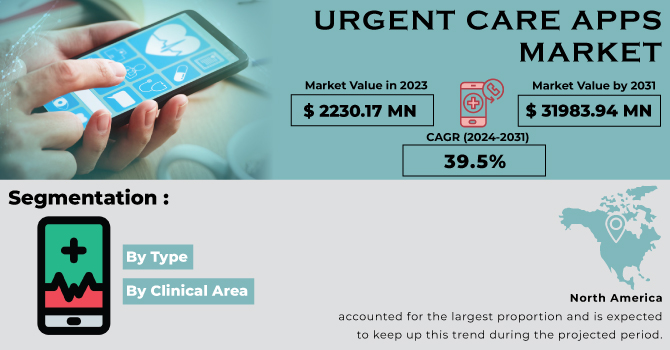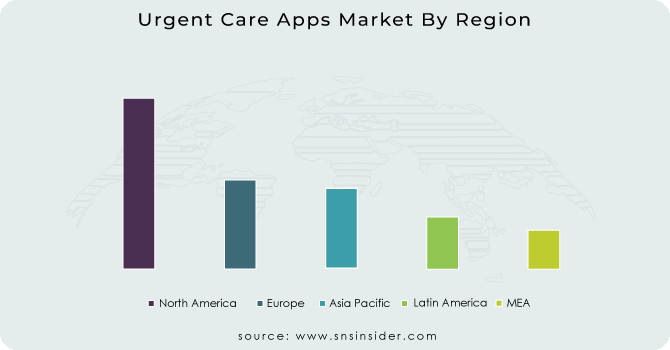Urgent Care Apps Market Report Scope & Overview:
The Urgent Care Apps Market Size was valued at USD 2230.17 million in 2023 and is expected to reach USD 31983.94 million by 2031 and grow at a CAGR of 39.5% over the forecast period 2024-2031.
Smartphone apps called "urgent care apps" can be used from a distance. These apps have the capacity to alert medical staff members like nurses and doctors about crises. In the event of an emergency, users of urgent care apps can quickly contact with the closest or registered healthcare facility. These in-home care apps are widely utilised, typically by the elderly population. Long wait times and expensive ER visits can now be reduced with the help of urgent care apps. Additionally, they can serve as a tool for patient participation and drastically save healthcare expenses.

Get more information on Urgent Care Apps Market - Request Sample Report
Due to the rise in smartphone usage and expansion of 3G and 4G networks, the demand for urgent care apps has increased. Additionally, a growing global emphasis on providing healthcare that is patient-centered fuels market expansion. However, it is projected that weak internet connectivity in underdeveloped nations may impede industry expansion. On the other hand, a rise in the number of smartphone users and a growing awareness of medication management apps, particularly among patients in developing countries, are predicted to create sizable business potential for market participants.
MARKET DYNAMICS
DRIVERS
-
Simplicity of Communication
-
Keeping Healthcare Delivery Costs Under Control
-
The Use of Smartphones Is Spreading
-
4G and 3G network penetration is expanding
-
Patient-Centered Healthcare Delivery is Receiving More Attention
RESTRAINTS
-
Application use for consumer instant messaging
-
Insufficient Internet Access in Several Countries
OPPORTUNITIES
-
Developing nations
CHALLENGES
-
Large Number of Mislabeled Apps in the Apple and Android Stores
By Type
Pre-hospital emergency care & triaging apps, in-hospital communication & collaboration apps, and post-hospital apps are the market segments. The majority of the market was occupied by the post-hospital apps category. The significant market share of this sector is primarily attributable to patients becoming more aware of mobile apps to manage their medications and to an increase in demand for medication management and rehabilitation apps as a result of the rising number of stroke, trauma, and cardiac patients who require rehabilitation support during post-hospital care.
By Clinical Area
Trauma, stroke, cardiac issues, and other clinical areas are divided into categories in the market. The market for urgent care apps is predicted to be dominated by the trauma category. The expansion of this market segment is being driven by the rising number of traffic accidents around the world. The usage of applications to manage trauma and casualty among paramedics and emergency centers is expanding at the same time that awareness of the need to handle trauma is rising as a result of ongoing initiatives by health organisations, such as WHO.
KEY MARKET SEGMENTS:
By Type
-
Pre-hospital Emergency Care & Triaging Apps
-
In-hospital Communication & Collaboration Apps
-
Post-hospital Apps
-
Rehabilitation Apps
-
Care Provider Communication & Collaboration Apps
By Clinical Area
-
Trauma
-
Stroke
-
Cardiac Conditions
-
Other Clinical Areas
REGIONAL ANALYSIS
The markets for urgent care apps in North America, Europe, Asia-Pacific, and LAMEA are all examined regionally. Because of its huge population, widespread use of smart phones, and established high-speed internet infrastructure, North America accounted for the largest proportion and is expected to keep up this trend during the projected period. This is anticipated to increase market demand for urgent care apps.

Need any customization research on Urgent Care Apps Market - Enquiry Now
REGIONAL COVERAGE:
-
North America
-
USA
-
Canada
-
Mexico
-
-
Europe
-
Germany
-
UK
-
France
-
Italy
-
Spain
-
The Netherlands
-
Rest of Europe
-
-
Asia-Pacific
-
Japan
-
south Korea
-
China
-
India
-
Australia
-
Rest of Asia-Pacific
-
-
The Middle East & Africa
-
Israel
-
UAE
-
South Africa
-
Rest of Middle East & Africa
-
-
Latin America
-
Brazil
-
Argentina
-
Rest of Latin America
-
KEY PLAYERS:
Some of the major key players are All m Inc., Hospify, Pul sara, Johnson & Johnson, Pivot Design Group, Medi safe, Alaya care, Smart patient, Siilo, Patient safe Solutions, and other players.
Johnson & Johnson-Company Financial Analysis

| Report Attributes | Details |
|---|---|
| Market Size in 2023 | US$ 2230.17 Million |
| Market Size by 2031 | US$ 31983.94 Million |
| CAGR | CAGR of 39.5% From 2024 to 2031 |
| Base Year | 2023 |
| Forecast Period | 2024-2031 |
| Historical Data | 2020-2022 |
| Report Scope & Coverage | Market Size, Segments Analysis, Competitive Landscape, Regional Analysis, DROC & SWOT Analysis, Forecast Outlook |
| Key Segments | • By Type (Pre-hospital Emergency Care & Triaging Apps, In-hospital Communication & Collaboration Apps, Post-hospital Apps (Medication Management Apps, Rehabilitation Apps, Care Provider Communication & Collaboration Apps)) • By Clinical Area (Trauma, Stroke, Cardiac Conditions, Other Clinical Areas) |
| Regional Analysis/Coverage | North America (USA, Canada, Mexico), Europe (Germany, UK, France, Italy, Spain, Netherlands, Rest of Europe), Asia-Pacific (Japan, South Korea, China, India, Australia, Rest of Asia-Pacific), The Middle East & Africa (Israel, UAE, South Africa, Rest of Middle East & Africa), Latin America (Brazil, Argentina, Rest of Latin America) |
| Company Profiles | All m Inc., Hospify, Pul sara, Johnson & Johnson, Pivot Design Group, Medi safe, Alaya care, Smart patient, Siilo, Patient safe Solutions, and other players. |
| DRIVERS | • Simplicity of Communication • Keeping Healthcare Delivery Costs Under Control • The Use of Smartphones Is Spreading |
| RESTRAINTS | • Application use for consumer instant messaging • Insufficient Internet Access in Several Countries |

